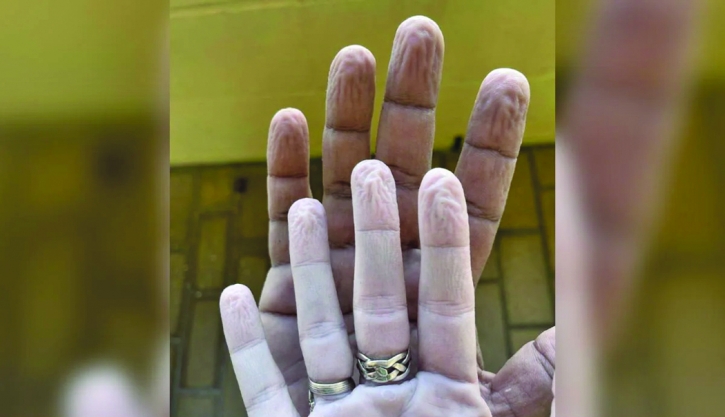
Ever noticed that the skin on fingers and toes shrivels up like an old prune when soaked in the bath? The water-induced wrinkling of skin has occupied the thoughts and work of scientists for several years. Over the years, scientists have tried to understand the cause and the purpose it may serve.
It takes around 3.5 minutes in warm water and 10 minutes in cool water for fingertips to start wrinkling, according to a BBC report. However, it takes up to 30 minutes of soaking time to reach maximum wrinkle.
a
Earlier, fingertip wrinkling was thought to be a passive response where the upper layers of the skin swelled as water flooded into the cells via a process known as osmosis - where water molecules move across a membrane to equalise the concentration of the solutions on either side. But by 1935, scientists said patients with injuries that had severed the median nerve - one of the main nerves that run down the arm to the hand - found that their fingers did not wrinkle. Their discovery suggested that the water-induced wrinkling of fingertips was in fact controlled by the nervous system.
In the 1970s, scientists proposed using the immersion of the hands in water as a simple bedside test to assess nerve damage that might affect the regulation of unconscious processes such as blood flow, BBC reported.
By 2023, neurologists Einar Wilder-Smith and Adeline Chow found that the fingertips of the volunteers began to wrinkle when there was a significant drop in the blood flow.
Pablo Saez Vinas, a biomechanical engineer at the Technical University of Catalonia, who has used computer modelling to examine the mechanism told BBC, "You need both to have normal levels of wrinkles if you don't have that neurological response, which happens in some individuals, wrinkles are inhibited."
If wrinkling is controlled by nerves then it means our bodies are actively reacting to being in the water. "That means it is happening for a reason, and that means it could be giving us an advantage, Davis told the media outlet.
With the help of 500 volunteers, Davis measured how much force they needed to use to grip a plastic object. Davis found out that those with dry, unwrinkled hands needed less force than people whose hands were wet - so their grip on the object was better. But when they submerged their hands in a water bath for a few minutes to turn them wrinkly, the grip force fell between the two even though their hands were still wet.
"The results were amazingly clear," he said. "The wrinkling increased the amount of friction between the fingers and the object. What is particularly interesting is that our fingers are sensitive to this change in surface friction. We use this information to apply less force to grip an object securely," he added.
He further explained, "If you don't have to squeeze as hard to grip something, the muscles in your hands get less tired and so you can do it for longer."
His findings match those of other researchers who have found that the wrinkling of our fingertips makes it easier for us to handle wet objects.
The study suggests that humans may have evolved fingertip and toe wrinkling at some point in the past to help us grip wet objects and surfaces.





































